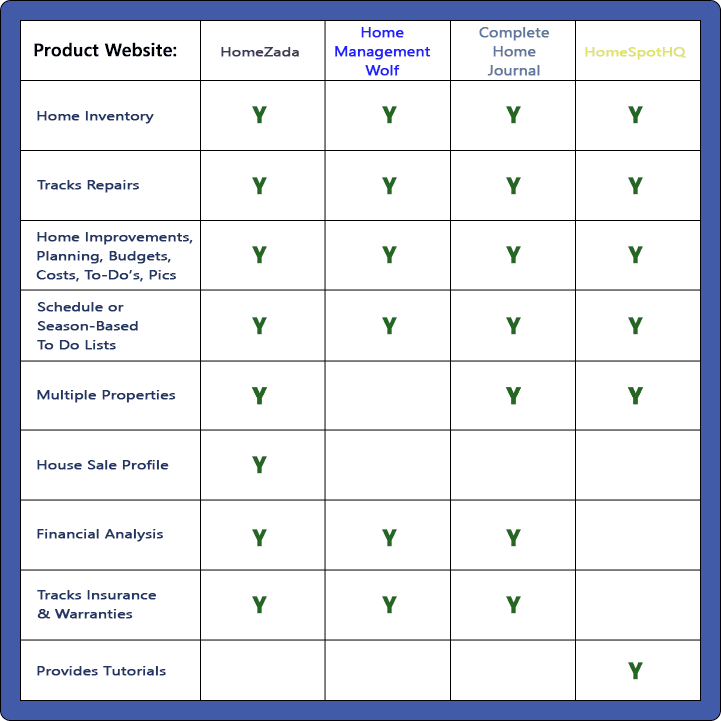A search on the internet shows most maintenance management literature and software is devoted to medium to large-sized institutions and much less to micro-sized organizations and especially much less to the home and the individual. This makes sense: the art and science of maintenance management were born in large organizations, and the record-keeping necessary to maintain the equipment and facilities of that size of an organization is immense.
At the level of the household, this is much less true. The number of large assets in a household is usually small – the house itself, its roof and rooms, the household’s vehicles, kitchen appliances, bathroom appliances, other home appliances, furnace, air conditioner, computers, TVs, furniture, and lawn equipment. I’m leaving several common items out, and every house may have other, slightly unusual features such as solar panels or a boat in the garage or large, elaborate grounds, but the point is that in comparison to even a modest size company the equipment and rooms the average house contains will be either fewer in number or smaller in size or complexity or both.
Add to that a large amount of home maintenance is farmed out – an auto mechanic will repair the car, a plumber the pipes, and so on. In the home itself, there is probably not going to be a maintenance staff unless the owners take on that role themselves.
One might conclude from this that only the largest mansions should consider implementing a maintenance management plan, but that probably is incorrect – the average household is actually more complex than I have described it. Here are a few examples:
 Overall, these packages emphasize To-do lists for routine maintenance. Preventive maintenance seems to be limited to performing maintenance on a schedule rather than according to meter or gauge or another method.
The financial aspect of owning a house (increasing its value, preparing for sale, maintaining financial records) seems to take higher priority in home management software than you might find in a corporate CMMS. In the corporate world, this analysis might be done in another software package than the CMMS.
Lawn maintenance, garden maintenance, and vehicle maintenance software does exist but normally does not seem to be part of home management software. They each seem to have their own niche.
There are other types of software packages that have somewhat the same purpose as home management software. One category is software that helps homeowners locate contractors to perform maintenance on their houses. “Angi” is one well-known example of this. “Home Binder” does this as well, and also emphasizes record tracking of household financial documents and maintenance records as well. Again, the goal is to increase the value of the home.
Smart home technology may also dramatically change home maintenance management. Smart devices include refrigerators, stoves, exercise equipment, etc. Here is one list of what is popular in the year 2021: “The 15 Best Smart Appliances For Your Home in 2022“. Some of these appliances can have their “health” monitored by sensors that detect and report electrical, moisture, ultrasonic, vibration, and temperature abnormalities. The article, “3 Smart Maintenance Solutions to Get More from Asset Data,” describes how this works in some detail.
It turns out that Maintenance Management for the home turns out to be important enough for a category of software to have developed around it. This software as one would expect is much more rudimentary than what is found at the level of the corporation. However, the world of maintenance management for the home is changing dramatically and becoming much more sophisticated as smart home technology becomes more ubiquitous. It will be interesting to see how home maintenance software and smart home technology compete and/or cooperate with each other in the future.
RELATED ARTICLES
Overall, these packages emphasize To-do lists for routine maintenance. Preventive maintenance seems to be limited to performing maintenance on a schedule rather than according to meter or gauge or another method.
The financial aspect of owning a house (increasing its value, preparing for sale, maintaining financial records) seems to take higher priority in home management software than you might find in a corporate CMMS. In the corporate world, this analysis might be done in another software package than the CMMS.
Lawn maintenance, garden maintenance, and vehicle maintenance software does exist but normally does not seem to be part of home management software. They each seem to have their own niche.
There are other types of software packages that have somewhat the same purpose as home management software. One category is software that helps homeowners locate contractors to perform maintenance on their houses. “Angi” is one well-known example of this. “Home Binder” does this as well, and also emphasizes record tracking of household financial documents and maintenance records as well. Again, the goal is to increase the value of the home.
Smart home technology may also dramatically change home maintenance management. Smart devices include refrigerators, stoves, exercise equipment, etc. Here is one list of what is popular in the year 2021: “The 15 Best Smart Appliances For Your Home in 2022“. Some of these appliances can have their “health” monitored by sensors that detect and report electrical, moisture, ultrasonic, vibration, and temperature abnormalities. The article, “3 Smart Maintenance Solutions to Get More from Asset Data,” describes how this works in some detail.
It turns out that Maintenance Management for the home turns out to be important enough for a category of software to have developed around it. This software as one would expect is much more rudimentary than what is found at the level of the corporation. However, the world of maintenance management for the home is changing dramatically and becoming much more sophisticated as smart home technology becomes more ubiquitous. It will be interesting to see how home maintenance software and smart home technology compete and/or cooperate with each other in the future.
RELATED ARTICLES
- 81% of all Americans have a lawn
- 31% of all Americans have a garden
- 5.2% of all Americans are preppers or “Resilient Citizens”
- There are 38 million home-based businesses
 Overall, these packages emphasize To-do lists for routine maintenance. Preventive maintenance seems to be limited to performing maintenance on a schedule rather than according to meter or gauge or another method.
The financial aspect of owning a house (increasing its value, preparing for sale, maintaining financial records) seems to take higher priority in home management software than you might find in a corporate CMMS. In the corporate world, this analysis might be done in another software package than the CMMS.
Lawn maintenance, garden maintenance, and vehicle maintenance software does exist but normally does not seem to be part of home management software. They each seem to have their own niche.
There are other types of software packages that have somewhat the same purpose as home management software. One category is software that helps homeowners locate contractors to perform maintenance on their houses. “Angi” is one well-known example of this. “Home Binder” does this as well, and also emphasizes record tracking of household financial documents and maintenance records as well. Again, the goal is to increase the value of the home.
Smart home technology may also dramatically change home maintenance management. Smart devices include refrigerators, stoves, exercise equipment, etc. Here is one list of what is popular in the year 2021: “The 15 Best Smart Appliances For Your Home in 2022“. Some of these appliances can have their “health” monitored by sensors that detect and report electrical, moisture, ultrasonic, vibration, and temperature abnormalities. The article, “3 Smart Maintenance Solutions to Get More from Asset Data,” describes how this works in some detail.
It turns out that Maintenance Management for the home turns out to be important enough for a category of software to have developed around it. This software as one would expect is much more rudimentary than what is found at the level of the corporation. However, the world of maintenance management for the home is changing dramatically and becoming much more sophisticated as smart home technology becomes more ubiquitous. It will be interesting to see how home maintenance software and smart home technology compete and/or cooperate with each other in the future.
RELATED ARTICLES
Overall, these packages emphasize To-do lists for routine maintenance. Preventive maintenance seems to be limited to performing maintenance on a schedule rather than according to meter or gauge or another method.
The financial aspect of owning a house (increasing its value, preparing for sale, maintaining financial records) seems to take higher priority in home management software than you might find in a corporate CMMS. In the corporate world, this analysis might be done in another software package than the CMMS.
Lawn maintenance, garden maintenance, and vehicle maintenance software does exist but normally does not seem to be part of home management software. They each seem to have their own niche.
There are other types of software packages that have somewhat the same purpose as home management software. One category is software that helps homeowners locate contractors to perform maintenance on their houses. “Angi” is one well-known example of this. “Home Binder” does this as well, and also emphasizes record tracking of household financial documents and maintenance records as well. Again, the goal is to increase the value of the home.
Smart home technology may also dramatically change home maintenance management. Smart devices include refrigerators, stoves, exercise equipment, etc. Here is one list of what is popular in the year 2021: “The 15 Best Smart Appliances For Your Home in 2022“. Some of these appliances can have their “health” monitored by sensors that detect and report electrical, moisture, ultrasonic, vibration, and temperature abnormalities. The article, “3 Smart Maintenance Solutions to Get More from Asset Data,” describes how this works in some detail.
It turns out that Maintenance Management for the home turns out to be important enough for a category of software to have developed around it. This software as one would expect is much more rudimentary than what is found at the level of the corporation. However, the world of maintenance management for the home is changing dramatically and becoming much more sophisticated as smart home technology becomes more ubiquitous. It will be interesting to see how home maintenance software and smart home technology compete and/or cooperate with each other in the future.
RELATED ARTICLES
- Maintenance Management and the Internet of Things
- Ultimate Guide to Complete Home Maintenance
- Awesome Home Improvement Advice
- The Best First-Time Home Buying Guide
- About Us
###


